2015 RENAULT CLIO SPORT TOURER weight
[x] Cancel search: weightPage 159 of 252
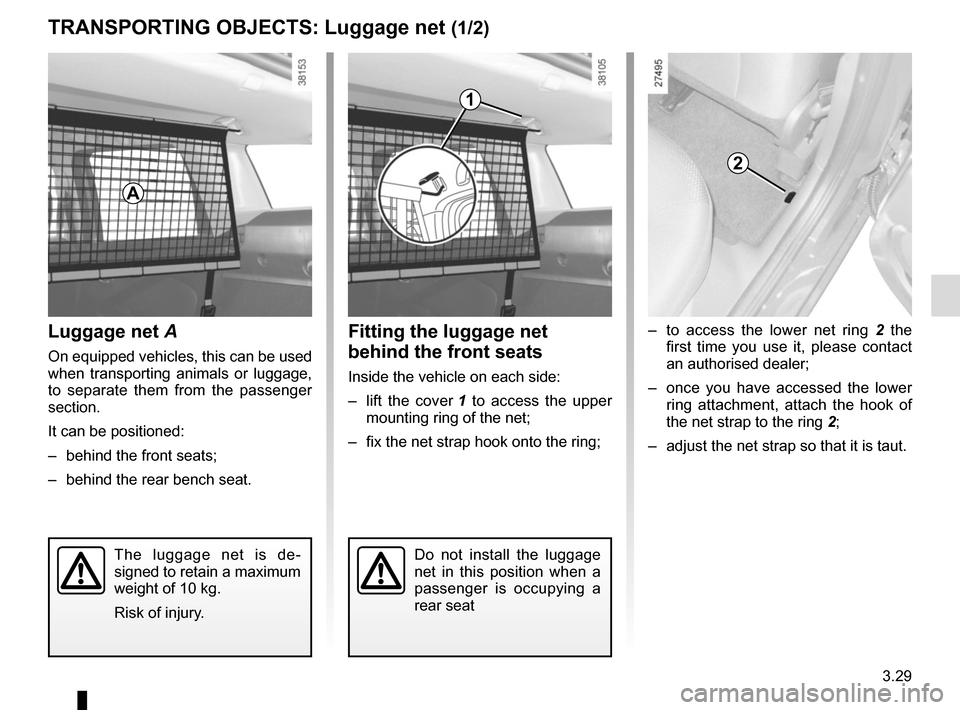
3.29
TRANSPORTING OBJECTS: Luggage net (1/2)
Luggage net A
On equipped vehicles, this can be used
when transporting animals or luggage,
to separate them from the passenger
section.
It can be positioned:
– behind the front seats;
– behind the rear bench seat.
Fitting the luggage net
behind the front seats
Inside the vehicle on each side:
– lift the cover 1 to access the upper
mounting ring of the net;
– fix the net strap hook onto the ring; – to access the lower net ring
2 the
first time you use it, please contact
an authorised dealer;
– once you have accessed the lower ring attachment, attach the hook of
the net strap to the ring 2;
– adjust the net strap so that it is taut.
2
The luggage net is de-
signed to retain a maximum
weight of 10 kg.
Risk of injury.Do not install the luggage
net in this position when a
passenger is occupying a
rear seat
1
A
Page 165 of 252
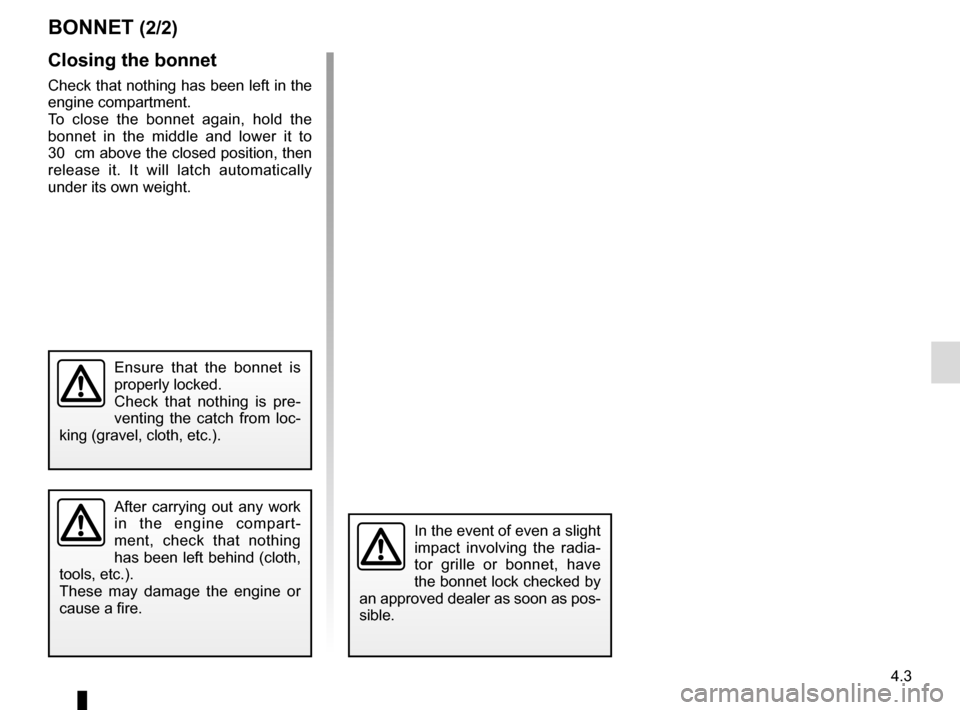
4.3
Closing the bonnet
Check that nothing has been left in the
engine compartment.
To close the bonnet again, hold the
bonnet in the middle and lower it to
30 cm above the closed position, then
release it. It will latch automatically
under its own weight.
After carrying out any work
in the engine compart-
ment, check that nothing
has been left behind (cloth,
tools, etc.).
These may damage the engine or
cause a fire.
Ensure that the bonnet is
properly locked.
Check that nothing is pre-
venting the catch from loc-
king (gravel, cloth, etc.).
In the event of even a slight
impact involving the radia-
tor grille or bonnet, have
the bonnet lock checked by
an approved dealer as soon as pos-
sible.
BONNET (2/2)
Page 173 of 252
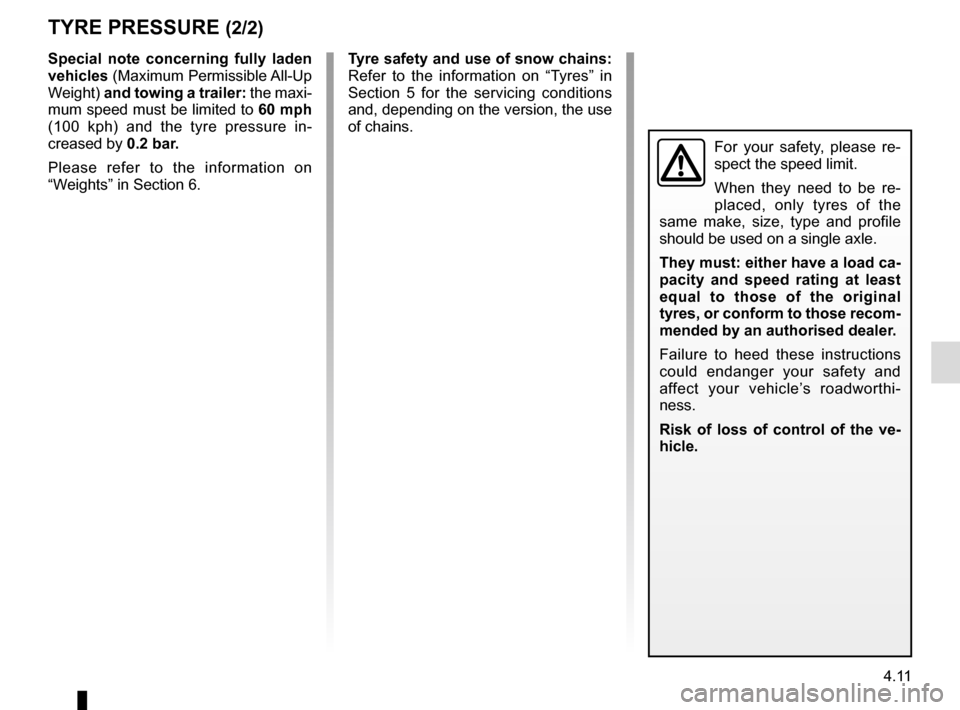
4.11
TYRE PRESSURE (2/2)
Special note concerning fully laden
vehicles (Maximum Permissible All-Up
Weight) and towing a trailer: the maxi-
mum speed must be limited to 60 mph
(100 kph) and the tyre pressure in-
creased by 0.2 bar.
Please refer to the information on
“Weights” in Section 6. Tyre safety and use of snow chains:
Refer to the information on “Tyres” in
Section 5 for the servicing conditions
and, depending on the version, the use
of chains.
For your safety, please re-
spect the speed limit.
When they need to be re-
placed, only tyres of the
same make, size, type and profile
should be used on a single axle.
They must: either have a load ca-
pacity and speed rating at least
equal to those of the original
tyres, or conform to those recom-
mended by an authorised dealer.
Failure to heed these instructions
could endanger your safety and
affect your vehicle’s roadworthi-
ness.
Risk of loss of control of the ve-
hicle.
Page 216 of 252
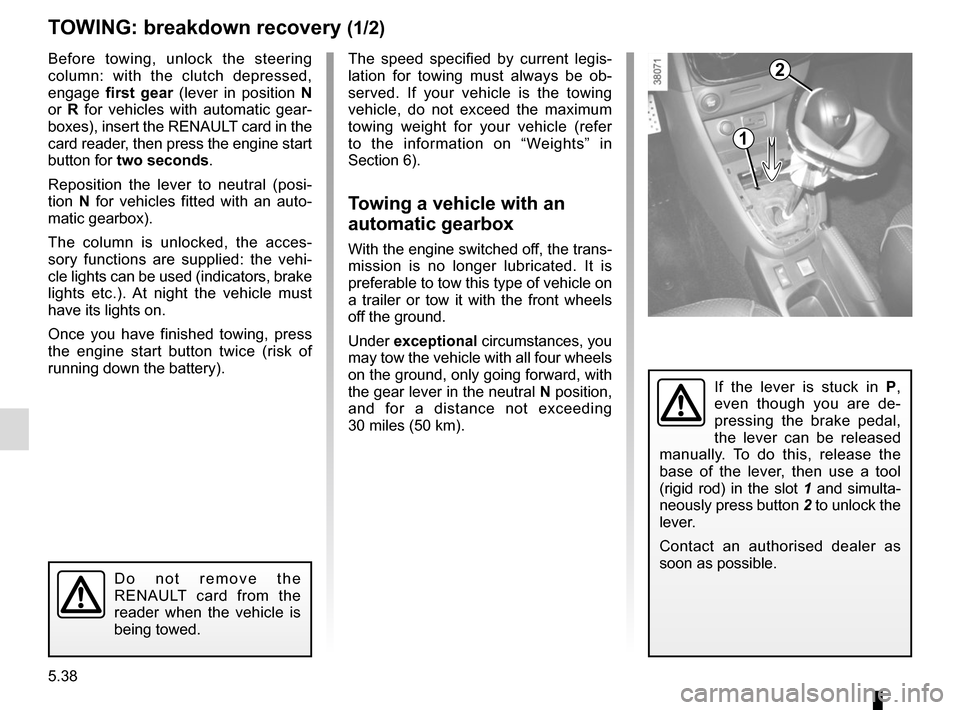
5.38
TOWING: breakdown recovery (1/2)
Before towing, unlock the steering
column: with the clutch depressed,
engage first gear (lever in position N
or R for vehicles with automatic gear-
boxes), insert the RENAULT card in the
card reader, then press the engine start
button for two seconds.
Reposition the lever to neutral (posi-
tion N for vehicles fitted with an auto-
matic gearbox).
The column is unlocked, the acces-
sory functions are supplied: the vehi-
cle lights can be used (indicators, brake
lights etc.). At night the vehicle must
have its lights on.
Once you have finished towing, press
the engine start button twice (risk of
running down the battery). The speed specified by current legis-
lation for towing must always be ob-
served. If your vehicle is the towing
vehicle, do not exceed the maximum
towing weight for your vehicle (refer
to the information on “Weights” in
Section 6).
Towing a vehicle with an
automatic gearbox
With the engine switched off, the trans-
mission is no longer lubricated. It is
preferable to tow this type of vehicle on
a trailer or tow it with the front wheels
off the ground.
Under
exceptional circumstances, you
may tow the vehicle with all four wheels
on the ground, only going forward, with
the gear lever in the neutral N position,
and for a distance not exceeding
30 miles (50 km).
Do not remove the
RENAULT card from the
reader when the vehicle is
being towed.
If the lever is stuck in P ,
even though you are de-
pressing the brake pedal,
the lever can be released
manually. To do this, release the
base of the lever, then use a tool
(rigid rod) in the slot 1 and simulta-
neously press button 2 to unlock the
lever.
Contact an authorised dealer as
soon as possible.
1
2
Page 225 of 252
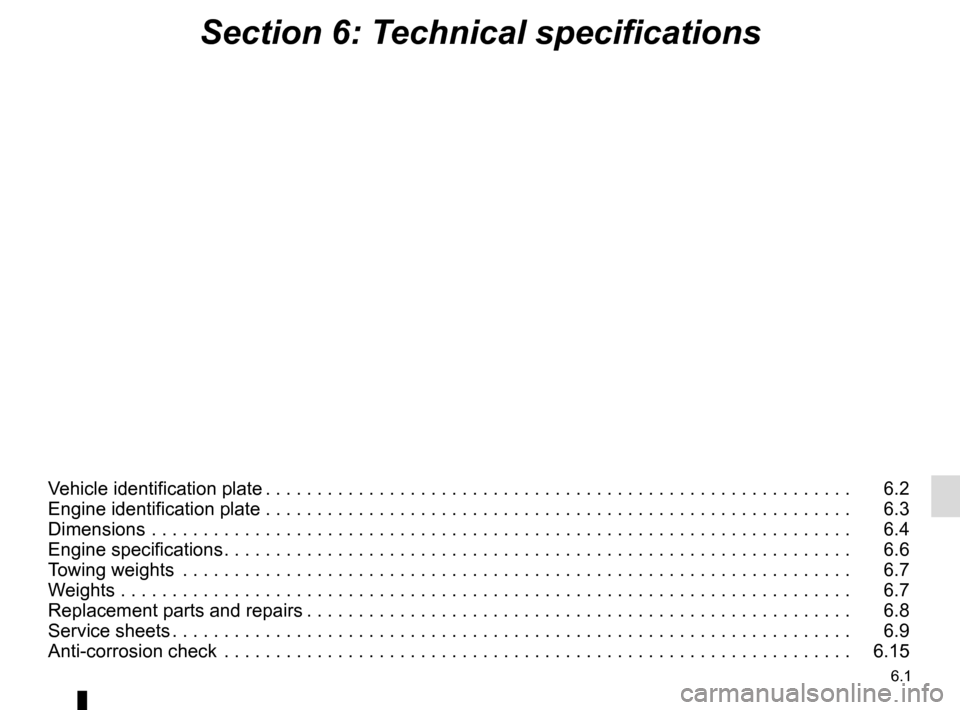
6.1
Section 6: Technical specifications
Vehicle identification plate . . . . . . . . . . . . . . . . . . . . . . . . . . . . . . . . . . . . \
. . . . . . . . . . . . . . . . . . . . . 6.2
Engine identification plate . . . . . . . . . . . . . . . . . . . . . . . . . . . . . . . . . . . .\
. . . . . . . . . . . . . . . . . . . . . 6.3
Dimensions . . . . . . . . . . . . . . . . . . . . . . . . . . . . . . . . . . . .\
. . . . . . . . . . . . . . . . . . . . . . . . . . . . . . . . 6.4
Engine specifications . . . . . . . . . . . . . . . . . . . . . . . . . . . . . . . . . . . . \
. . . . . . . . . . . . . . . . . . . . . . . . . 6.6
Towing weights . . . . . . . . . . . . . . . . . . . . . . . . . . . . . . . . . . . .\
. . . . . . . . . . . . . . . . . . . . . . . . . . . . . 6.7
Weights . . . . . . . . . . . . . . . . . . . . . . . . . . . . . . . . . . . .\
. . . . . . . . . . . . . . . . . . . . . . . . . . . . . . . . . . . 6.7
Replacement parts and repairs . . . . . . . . . . . . . . . . . . . . . . . . . . . . . . . . . . . . \
. . . . . . . . . . . . . . . . . 6.8
Service sheets . . . . . . . . . . . . . . . . . . . . . . . . . . . . . . . . . . . . \
. . . . . . . . . . . . . . . . . . . . . . . . . . . . . . 6.9
Anti-corrosion check . . . . . . . . . . . . . . . . . . . . . . . . . . . . . . . . . . . .\
. . . . . . . . . . . . . . . . . . . . . . . . . 6.15
Page 226 of 252
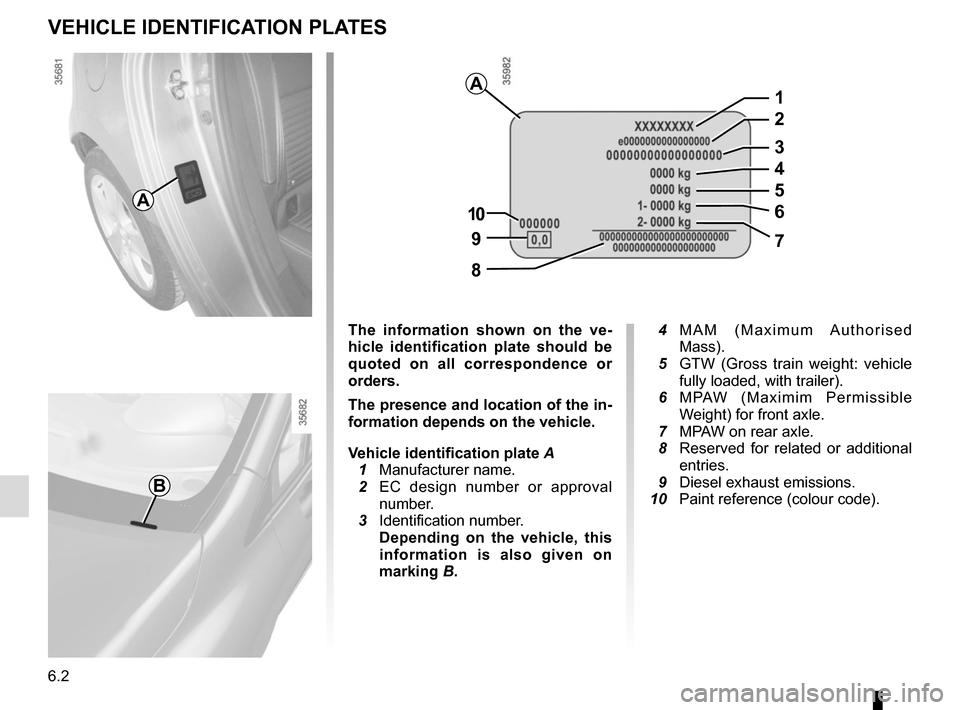
6.2
VEHICLE IDENTIFICATION PLATES
A
B
The information shown on the ve-
hicle identification plate should be
quoted on all correspondence or
orders.
The presence and location of the in-
formation depends on the vehicle.
Vehicle identification plate A
1 Manufacturer name.
2 EC design number or approval
number.
3 Identification number.
Depending on the vehicle, this
information is also given on
marking B.
4 MAM (Maximum Authorised
Mass).
5 GTW (Gross train weight: vehicle
fully loaded, with trailer).
6 MPAW (Maximim Permissible
Weight) for front axle.
7 MPAW on rear axle.
8 Reserved for related or additional
entries.
9 Diesel exhaust emissions.
10 Paint reference (colour code).
A
97
8
10
5
1
2
3
4
6
Page 231 of 252
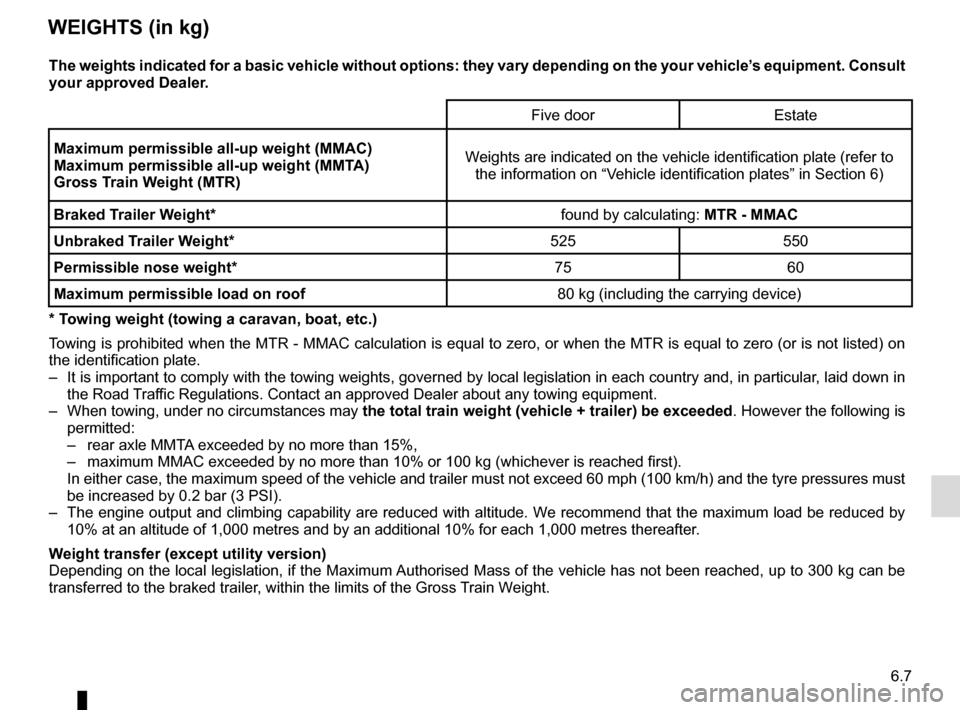
6.7
WEIGHTS (in kg)
The weights indicated for a basic vehicle without options: they vary dep\
ending on the your vehicle’s equipment. Consult
your approved Dealer.Five door Estate
Maximum permissible all-up weight (MMAC)
Maximum permissible all-up weight (MMTA)
Gross Train Weight (MTR) Weights are indicated on the vehicle identification plate (refer to
the information on “Vehicle identification plates” in Section 6)
Braked Trailer Weight* found by calculating: MTR - MMAC
Unbraked Trailer Weight* 525 550
Permissible nose weight* 75 60
Maximum permissible load on roof 80 kg (including the carrying device)
* Towing weight (towing a caravan, boat, etc.)
Towing is prohibited when the MTR - MMAC calculation is equal to zero, or\
when the MTR is equal to zero (or is not listed) on
the identification plate.
– It is important to comply with the towing weights, governed by local leg\
islation in each country and, in particular, laid down in the Road Traffic Regulations. Contact an approved Dealer about any towing equipment.
– When towing, under no circumstances may the total train weight (vehicle + trailer) be exceeded . However the following is
permitted:
– rear axle MMTA exceeded by no more than 15%,
– maximum MMAC exceeded by no more than 10% or 100 kg (whichever is reach\
ed first).
In either case, the maximum speed of the vehicle and trailer must not ex\
ceed 60 mph (100 km/h) and the tyre pressures must be increased by 0.2 bar (3 PSI).
– The engine output and climbing capability are reduced with altitude. We recommend that the maximum load be reduced by 10% at an altitude of 1,000 metres and by an additional 10% for each 1,0\
00 metres thereafter.
Weight transfer (except utility version)
Depending on the local legislation, if the Maximum Authorised Mass of the vehicle has not been reached, up to 300 kg can be\
transferred to the braked trailer, within the limits of the Gross Train Weight.
Page 248 of 252

7.4
ALPHABETICAL INDEX (4/5)
P
paintworkmaintenance ..................................................... 4.13 – 4.14
parking distance control.......................................... 2.34 – 2.35
power-assisted steering.................................................\
.... 1.49
pretensioners .........................................................1\
.22 → 1.25
puncture.......................................... 5.2 → 5.5, 5.9, 5.11 – 5.12
R
radio...................................................................\
................ 3.32
rear bench seat.........................................................\
......... 3.22
rear parcel shelf ................................................................. 3.24
rear seats..............................................................\
............. 1.20 functions ..............................................................\
........ 3.22
rear view mirrors ................................................................ 1.72
RENAULT ANTI-INTRUDER DEVICE (RAID) ................... 1.13
RENAULT card battery ................................................................\
.......... 5.26
use ..................................................... 1.2 → 1.8, 2.3 → 2.5
RENAULT card battery ...................................................... 5.26
replacement parts ................................................................ 6.8
reverse gear selecting ..............................................................\
......... 2.12
reversing sensor ..................................................... 2.34 – 2.35
roof bars ........................................................................\
.... 3.31
roof rack roof bars ....................................................................... 3.31
running in ........................................................................\
..... 2.2
S
seat belt pretensioners front seat belt ...................................................1.22 → 1.25
seat belts ......................................................1.18 → 1.25, 1.28
service sheets..........................................................\
6.9 → 6.14
side protection devices ...................................................... 1.27
signals and lights ...................................................1.73 → 1.77speakers
location ...............................................................\
......... 5.34
special features of diesel versions.....................................\
2.11
special features of petrol vehicles ..................................... 2.10
speed limiter .................................................1.57, 2.27 → 2.29
starting the engine .....................................................2.3 → 2.9
steering wheel adjustment .............................................................\
...... 1.49
Stop & Start ......................................................1.57, 2.6 → 2.9
Stop & Start function..................................................2.6 → 2.9
stopping the engine ...................................................2.3 → 2.5
storage compartment.............................................3.16 → 3.19
storage compartments ...........................................3.16 → 3.19
sun visor ........................................................................\
.... 3.14
switching on the vehicle ignition ................................2.3 → 2.5
T
tailgate ........................................................... 3.23, 3.26 – 3.27
tanks and reservoirs brake fluid ...................................................................... 4.8
coolant ................................................................\
........... 4.7
tanks and reservoirs: windscreen washer ........................................................ 4.9
technical specifications ..............................................6.4 → 6.8
telephone ..............................................................\
............. 3.32
temperature regulation ............................................ 3.7 → 3.11
tool kit ........................................................................\
.......... 5.9
towing breakdown ........................................................ 5.38 – 5.39
towing equipment ......................................................... 3.28
towing a caravan ........................................................ 3.28, 6.7
towing equipment fitting ................................................................\
............ 3.28
towing hitch...................................................... 5.9, 5.38 – 5.39
towing rings ............................................................ 3.26 – 3.27
towing weights ..................................................................... 6.7